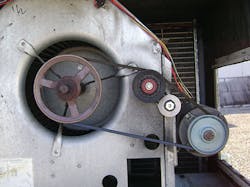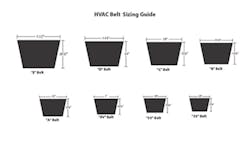When you adjust a pulley to squeeze a little more air out of a belt-driven fan, there are times you’ll find the old belt no longer fits. Let’s take a look at a few formulas and tips that can assure your success and make this system upgrade painless for you.
The first option to make a belt fit, is to loosen the bolts on the motor mount and slide the motor as close to the fan as possible to see if the belt will slip over the edge of the pulley. If that doesn’t work its time to surrender muscle to brainpower and calculate the size of a new belt.
Inspection
Start by inspecting the existing belt, motor, fan, and pulleys. Ensure the original belt’s groove size fits the pulleys and make sure the bearings, shafts, and set screws are in good condition and secure.
While you’re at it, inspect the motor mount, the fan, and housings to be certain they will remain in good working order after the new airflow is set and that the equipment will be able to operate long term.
Record the old belt number written on the exposed surface of the belt. This is your best reference to find the original size, type, and length of the belt.
If you don’t have the replacement belt on your truck, these numbers come in handy when verifying your measurements by cross referencing the belt number with the manufacturer’s online store or app. A faded page in a manufacturer’s catalog is more accurate than field belt and pulley measurements any day.
Belt Cross-Section
If the belt number is worn, faded or otherwise unreadable, be sure to verify the cross section sizes of the belt. Your choice will be critical to the long-term performance of the system.
In addition to correctly specifying the belt length, be certain to match the type of belt and the cross section or type matches the pulleys. When you measure these dimensions, be careful. Old belts may be badly worn, so the dimension may not be accurate. Use this cross section illustration to assure the correct belt height and width.
Do the Math
Now it’s time to use the “other tool,” a math formula to determine the length of the replacement belt. It’s recommended that you work the formula a few times before you try it in the field, just so you’re familiar with the math. Practice makes perfect.
Several measurements are required to complete the replacement belt formula. Measure and record the distance between the center of the motor shaft and the center of the fan pulley shaft. Measure the diameter of the motor pulley (also called the drive pulley or sheave) and the fan pulley (called the driven pulley).
Apply the following formula to determine a new replacement belt length:
Belt Length = 2C + [1.57 x (D1 + D2)] + 1”
Where
C = The distance between the motor and fan shafts
D1 = The Diameter of the smaller pulley
D2 = The Diameter of the larger pulley
The math is quite easy; it simply includes adding and multiplying. Here is a completed formula to guide you through the steps:
Example, Where
C = (12”) Distance between shafts
D1 = (3”) Diameter of the small pulley
D2 = (8”) Diameter of the large pulley
New Belt Length = 2C + [1.57 x (D1 + D2)] + 1”
2(12”) + [1.57 x (3”+ 8”)] + 1”
24” + [1.57 x 11”] + 1”
24” + 17.27” + 1” = 42.27”
So, select a new belt at the next length (43 inches), depending on the available room on your motor mount.
Find a Good Counter Guy or Gal
The key to success when selecting replacement belts is either a huge inventory, or a great counter guy or gal at your power transmission distributor. They know the right questions to ask and can almost finish your sentences once they get to know you or your company. Each is worth their weight in adjustable pulleys.
A Few Tips to be Aware Of
When increasing pulley size, always check amp draw immediately after making the change. Remember, amp draw increases at the cube of airflow, so a 10% increase in airflow may increase the power a motor draws by more than 30%. Pulley adjustments can be hazardous to the health of the motor. Do not leave a motor operating at more than full load amps.
Always measure fan RPM. Check the fan speed against the manufacturer’s fan data to be certain you don’t exceed the fan curve. Airflow may decrease with an increase in fan speed under certain conditions.
Adjusting the motor mount is accomplished by loosening the bolts that hold the motor onto the motor mount. Next, slide the motor closer to or farther away from the fan until the correct belt tightness is achieved, then tighten the bolts on the motor mount to hold the motor in place and keep the belt tight.
Sometimes you’ll need to loosen the set-screws on the pulley and slide them along the shaft until the pulleys line up with each other. Alignment increases efficiency and prolongs the life of the belt and pulleys.
How tight should the belt be adjusted? Too tight, and the power consumption may increase and equipment life could decrease. Too loose, and the belt squeals and slips. There are tools available to measure belt tension, if you adjust belts, you should have one.
The rule to use for belt tightness is that belt deflection with moderate pressure applied should be 1/32nd of the distance between the shafts of the fan and the motor. For example if there is 16” between shafts, belt deflection should be 16” divided by 32 or ½”.
One last tip: With blower motors over 10 horsepower (HP), it’s recommended that a good quality belt changeout include a second visit a day or two later to tighten the stretched belt by adjusting the motor mount. Belts do stretch and need to be re-tightened to perform their best.
Rob “Doc” Falke serves the industry as president of National Comfort Institute an HVAC based training company and membership organization. If you're an HVAC contractor or technician interested in a free belt-sizing technical procedure, contact Doc at [email protected] or call him at 800-633-7058. Go to NCI’s website at nationalcomfortinstitute.com for free information.
About the Author
Rob 'Doc' Falke
President
Rob “Doc” Falke serves the industry as president of National Comfort Institute an HVAC-based training company and membership organization. If you're an HVAC contractor or technician interested in a building pressure measurement procedure, contact Doc at [email protected] or call him at 800-633-7058. Go to NCI’s website at NationalComfortInstitute.com for free information, articles and downloads.


